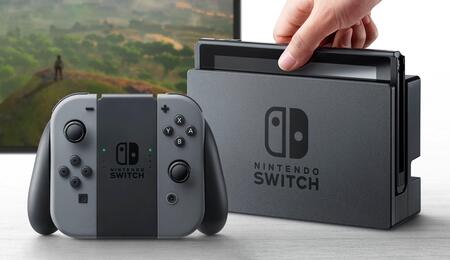Nintendo Switch

Nintendo Switch: new console may be weird, but it is for everyone
The Nintendo Switch is the weirdest games console to hit the market since … well, the last games console Nintendo released. When docked to the TV, the slim black device could be mistaken for one of the company’s previous consoles. The “Joy-Con” controllers give away that something’s up, though: even in their most traditional configuration, clicked in to a mounting device to be used as a classic dual-analogue-stick handset, they’re still fairly oddly shaped. But it’s when you unclip the Joy-Cons—with a smooth, satisfying click, and undock the Switch from its hub next to your TV, that the full rationale for the thing becomes clear. The controllers clip into the side of the 6in touchscreen, the game seamlessly continues working, and the whole system becomes portable. To a certain extent, it’s an evolution of the design that lay at the heart of the Wii U, Nintendo’s disastrous attempt to follow up the breakout hit it had with the motion-controlled Wii. The Wii U was oriented around the GamePad, a bulky wireless controller with a touchscreen in the centre, that could be used as a second screen for some games, or as the main screen for games played while the TV itself was turned off.
The idea may have been sound, but it failed to catch consumers’ imagination, with abysmal sales forcing the company to turn to the success of its 3DS mobile console for financial salvation. Despite that, there are obvious similarities between the Wii U and the Switch. The newer device, when undocked and used in its portable mode, looks like a sleek upgrade to the 2012 console’s controller – except the entire machine is contained in its slim form.
So is the Switch an evolution of the Wii U or an attempt to go down a different path entirely? Shinya Takahashi, director and general manager at Nintendo’s entertainment planning and development division, claims it’s really neither. “I think it’s the product of us applying all the knowledge that we’ve built up over the years of designing hardware systems, and putting that into one device,” he said.
“Certainly as a facet of that, we did look at some of the areas where people were, maybe, not fully satisfied with the Wii U hardware. For example, with Wii U, you could play on the Wii U gamepad, but you couldn’t play, really, away from the living room, and now that’s become possible with the Nintendo Switch.”
Takahashi’s career at Nintendo began in 1989, and he has fulfilled numerous roles in that time. He has worked in game development, starting out on the acclaimed Nintendo 64 version of jet ski racer, Wave Race, but he has also managed teams, overseeing projects like Pokémon Stadium and Wii Sports Motion. When Nintendo merged its software and hardware research division in 2015, it was Takahashi who was put in charge. In short, he’s the developer’s developer, the head of the Nintendo’s in-house creatives.
Takahashi’s deputy is Yoshiaki Koizumi, the general producer for the Switch, and the breakout star of Nintendo’s livestream event introducing the machine to the world. Where Takahashi is the picture of the Japanese otaku, bouncy and enthusiastic about the games he makes, Koizumi has managed to create a heartthrob persona. Cool and measured, he speaks and looks like he’s stepped out of an advert for Yamazaki whisky.
When asked about what distinguishes the Switch from the Wii U, he points out that the new device began with the two controllers. “This is something that Nintendo has done with some previous consoles, although it was quite a while back and so some may have forgotten,” he says. “We wanted to start with the premise of two or more people playing together.
“That idea was very important to us as a concept, and it’s an idea that we’re carrying forward as we’re thinking about how this hardware is different from previous generations.”
Koizumi backs this up by turning to one of the system’s two first-party launch games: 1-2 Switch, a party game plucked straight from the historical highs of Nintendo weirdness. The game tasks players with competing in a raft of bizarre minigames, from milking cows to rocking babies to sleep, using the Joy-Con controllers.
Notably, a significant chunk of the games are designed to be played without looking at the screen at all, instead relying on audio cues from the speakers and vibration from the controller. Nintendo intends players to look at each other while they play, with Koizumi pulling a playing card out of his pocket to demonstrate the similarities with card games of yore – and with Nintendo’s own history: the company started off making cards in Kyoto in 1889.
It’s a shame, then, that 1-2 Switch also breaks with another trend of Nintendo’s recent past, coming as a separate purchase rather than a pack-in title in the vein of Wii Sports and NintendoLand. Takahashi argues that the software fits in the broader spectrum of year-one titles, “starting with Mario Kart followed then by ARMS followed by Splatoon 2, and then, of course, working towards Super Mario Odyssey at the end of the year.
“So we felt that between this strong line-up, and the strength of the titles, as well as the strength of the 1-2 Switch software itself, that it didn’t feel to us that should be bundled with the hardware, but rather was something that we felt stands alone within that overall first-year line-up.”
But the lack of a bundled game adds to the already high cost of the Switch. Launching at £279.99, it’s the most expensive Nintendo console for a long time – and, in fact, the most expensive console on the market. Adding the £34.99 cost of 1-2 Switch would take it above the cost of even the premium edition of the Wii U, which launched at £300.
That cost is part of the reason that, although the Switch is being positioned as a hybrid console, the 3DS, Nintendo’s previous portable console, is sticking around. “The Switch isn’t necessarily a successor” to the 3DS, Takahashi says. “We’re releasing software into next year: the fact that it’s a system with a low price and a larger library makes it appealing to kids, who might want to buy it as their first console.”
To a certain extent, it’s an evolution of the design that lay at the heart of the Wii U, Nintendo’s disastrous attempt to follow up the breakout hit it had with the motion-controlled Wii. The Wii U was oriented around the GamePad, a bulky wireless controller with a touchscreen in the centre, that could be used as a second screen for some games, or as the main screen for games played while the TV itself was turned off.
The idea may have been sound, but it failed to catch consumers’ imagination, with abysmal sales forcing the company to turn to the success of its 3DS mobile console for financial salvation. Despite that, there are obvious similarities between the Wii U and the Switch. The newer device, when undocked and used in its portable mode, looks like a sleek upgrade to the 2012 console’s controller – except the entire machine is contained in its slim form.
So is the Switch an evolution of the Wii U or an attempt to go down a different path entirely? Shinya Takahashi, director and general manager at Nintendo’s entertainment planning and development division, claims it’s really neither. “I think it’s the product of us applying all the knowledge that we’ve built up over the years of designing hardware systems, and putting that into one device,” he said.
“Certainly as a facet of that, we did look at some of the areas where people were, maybe, not fully satisfied with the Wii U hardware. For example, with Wii U, you could play on the Wii U gamepad, but you couldn’t play, really, away from the living room, and now that’s become possible with the Nintendo Switch.”
Takahashi’s career at Nintendo began in 1989, and he has fulfilled numerous roles in that time. He has worked in game development, starting out on the acclaimed Nintendo 64 version of jet ski racer, Wave Race, but he has also managed teams, overseeing projects like Pokémon Stadium and Wii Sports Motion. When Nintendo merged its software and hardware research division in 2015, it was Takahashi who was put in charge. In short, he’s the developer’s developer, the head of the Nintendo’s in-house creatives.
Takahashi’s deputy is Yoshiaki Koizumi, the general producer for the Switch, and the breakout star of Nintendo’s livestream event introducing the machine to the world. Where Takahashi is the picture of the Japanese otaku, bouncy and enthusiastic about the games he makes, Koizumi has managed to create a heartthrob persona. Cool and measured, he speaks and looks like he’s stepped out of an advert for Yamazaki whisky.
When asked about what distinguishes the Switch from the Wii U, he points out that the new device began with the two controllers. “This is something that Nintendo has done with some previous consoles, although it was quite a while back and so some may have forgotten,” he says. “We wanted to start with the premise of two or more people playing together.
“That idea was very important to us as a concept, and it’s an idea that we’re carrying forward as we’re thinking about how this hardware is different from previous generations.”
Koizumi backs this up by turning to one of the system’s two first-party launch games: 1-2 Switch, a party game plucked straight from the historical highs of Nintendo weirdness. The game tasks players with competing in a raft of bizarre minigames, from milking cows to rocking babies to sleep, using the Joy-Con controllers.
Notably, a significant chunk of the games are designed to be played without looking at the screen at all, instead relying on audio cues from the speakers and vibration from the controller. Nintendo intends players to look at each other while they play, with Koizumi pulling a playing card out of his pocket to demonstrate the similarities with card games of yore – and with Nintendo’s own history: the company started off making cards in Kyoto in 1889.
It’s a shame, then, that 1-2 Switch also breaks with another trend of Nintendo’s recent past, coming as a separate purchase rather than a pack-in title in the vein of Wii Sports and NintendoLand. Takahashi argues that the software fits in the broader spectrum of year-one titles, “starting with Mario Kart followed then by ARMS followed by Splatoon 2, and then, of course, working towards Super Mario Odyssey at the end of the year.
“So we felt that between this strong line-up, and the strength of the titles, as well as the strength of the 1-2 Switch software itself, that it didn’t feel to us that should be bundled with the hardware, but rather was something that we felt stands alone within that overall first-year line-up.”
But the lack of a bundled game adds to the already high cost of the Switch. Launching at £279.99, it’s the most expensive Nintendo console for a long time – and, in fact, the most expensive console on the market. Adding the £34.99 cost of 1-2 Switch would take it above the cost of even the premium edition of the Wii U, which launched at £300.
That cost is part of the reason that, although the Switch is being positioned as a hybrid console, the 3DS, Nintendo’s previous portable console, is sticking around. “The Switch isn’t necessarily a successor” to the 3DS, Takahashi says. “We’re releasing software into next year: the fact that it’s a system with a low price and a larger library makes it appealing to kids, who might want to buy it as their first console.”
S
Soft Secrets

.jpg)

